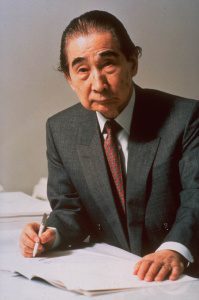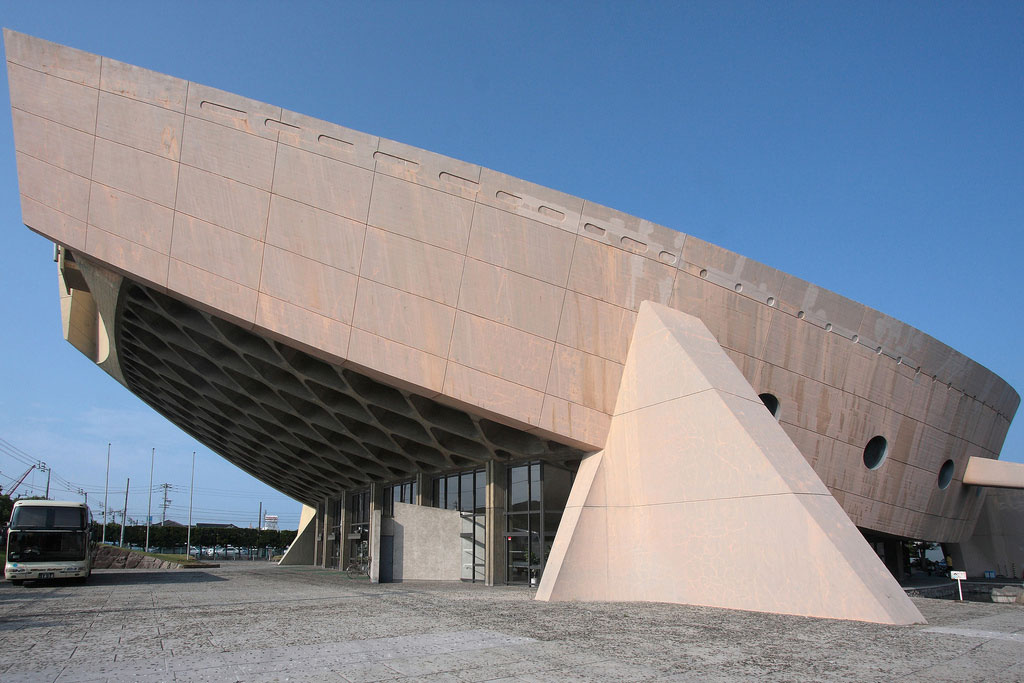ARCHITECTURE: Kenzo Tange
 As one of the eldest in a long line of architects that have made Japan one of the most revered countries in architecture, Pritzker-Prize Winning architect Kenzo Tange (4/9/1913-22/3/2005) helped define Japan’s post-WWII emergence into Modernism. Teacher, writer, architect, and urban planner, he is revered not only for his own work but also for his influence on younger architects. His stadiums for the Olympic Games held in Tokyo in 1964 are often described as among the most beautiful structures built in the 20th century.
As one of the eldest in a long line of architects that have made Japan one of the most revered countries in architecture, Pritzker-Prize Winning architect Kenzo Tange (4/9/1913-22/3/2005) helped define Japan’s post-WWII emergence into Modernism. Teacher, writer, architect, and urban planner, he is revered not only for his own work but also for his influence on younger architects. His stadiums for the Olympic Games held in Tokyo in 1964 are often described as among the most beautiful structures built in the 20th century.
By Dimitris Lempesis
 Kenzo Tange was born in (4/9/13 in the town of Imabari on Shikoku, the smallest of the four principal islands in the Japanese archipelago. Although becoming an architect was beyond his wildest dreams as a boy, it was Le Corbusier’s work that stirred his imagination so that in 1935, he became a student in the Architecture Department of Tokyo University. He received his degree in architecture in 1938 and returned to the university to do graduate studies in urban planning and design between 1942-45. The four intervening years were spent in the Tokyo architectural firm of Kunio Maekawa, who had worked in the Paris office of the great Swiss architect Le Corbusier and who was one of a small number of modern architects in Japan at the time. In 1949, after participating in planning studies to aid the rebuilding of numerous towns and cities, Tange won a national competition to design The Hiroshima Peace Center and Park. The complex, comprising a memorial, a museum, a community center, and an auditorium-hotel building, was completed in 1956. The free-standing memorial monument, a dramatic saddle-like arch made of reinforced concrete, is a 20th-century statement that recalls a building type in which the tombs of prehistoric Japanese rulers were placed. The museum, a long, horizontal structure of glass and concrete raised above ground on concrete columns, is reminiscent of buildings by Le Corbusier and also of ancient Japanese prototype. This theme of synthesizing modern architecture with traditional symbolism characterized the first phase of Tange’s career. Throughout the 1950s Tange was engaged in designing a variety of civic projects: town halls, libraries, auditoriums, sports centers. One of the more notable of these was the town hall complex he designed for his home town, Imabari, which was completed in 1959. Tange’s interest in such communal spaces dates back to his university studies of the Greek agora, the place, as Tange wrote, where the “citizen moved from the private realm to establish connections with society”. His doctorate, completed in 1959, was titled, “Spatial Structure in a Large City”, an interpretation of urban structure on the basis of people’s movements commuting to and from work. His “Plan for Tokyo 1960” was the Tange Team’s logical response to these problems, giving thought to the nature of the urban structure that would permit growth and change. Other urban design and planning projects were begun in 1967 for the Fiera District of Bologna, Italy, and for a new town with residences for 60,000 in Catania, Italy. For his Tokyo Cathedral of Saint Mary, he visited several medieval Gothic examples. Tange’s stupendous Yamanashi Press and Broadcasting Building in Kofu, a medium-size city in central Japan, inherits something of the plan’s monumental vision. Tange’s best-known buildings are the two national gymnasiums erected in Tokyo for the 1964 Olympic Games (the first to be held in Asia). The roofs of these two circular buildings indelibly recall the massive forms of traditional Japanese temples, but they are, also, altogether contemporary in form and technique. These roofs, suspended by cable from massive concrete pillars (a single pillar for the smaller structure, a pair for the larger), consist of prestressed steel nets onto which are attached welded steel plates. The drama of these forms continues in the interiors, bold, elegant, welcoming open spaces illuminated by a combination of artificial with natural light. From the mid-1960s onward Tange received widespread international attention and commissions. His firm, called the Urbanists and Architects Team (URTEC), provided the master plan (1965) for the reconstruction of Skopje, Yugoslavia, after its devastation by an earthquake and did important planning studies for cities and regions in Africa, the Middle East, and Europe as well as in Japan. Among Tange’s more important later architectural works is the Akasaka Hotel (1982) in central Tokyo, a bi-winged structure whose gleaming skin of aluminum and glass demonstrated a decisive turn away from the aesthetic of exposed concrete. In 1986 Tange again won a competition to design the New Tokyo City Hall Complex, as he had done in 1952. As all of his best work, the new design presents an impressive image: twin skyscraper towers, adorned at the top with panoply of communications equipment, rising like Cathedrals over the Shinjuku district in Tokyo. He also began work on the Otsu Prince Hotel, the United Nations University in Tokyo, and the Place d’Italie in Paris, France (completed 1991). An American example of his work is the American Medical Association Headquarters Building in Chicago, Illinois, completed in 1990. Tange has received numerous awards, including the Medal of Honour, Danish Royal Academy of Fine Arts, Grand Prix, Architectural Institute of Japan (1986), the Pritzker Architecture Prize (1987), Praemium Imperiale award for lifetime achievement in the arts (1993), Knight of the Legion of Honour of France (1996). In all of his projects, there is a recurrent theme that Tange has verbalized, “Architecture must have something that appeals to the human heart, but even then, basic forms, spaces and appearances must be logical. Creative work is expressed in our time as a union of technology and humanity. The role of tradition is that of a catalyst, which furthers a chemical reaction, but is no longer detectable in the end result. Tradition can, to be sure, participate in a creation, but it can no longer be creative itself”.
Kenzo Tange was born in (4/9/13 in the town of Imabari on Shikoku, the smallest of the four principal islands in the Japanese archipelago. Although becoming an architect was beyond his wildest dreams as a boy, it was Le Corbusier’s work that stirred his imagination so that in 1935, he became a student in the Architecture Department of Tokyo University. He received his degree in architecture in 1938 and returned to the university to do graduate studies in urban planning and design between 1942-45. The four intervening years were spent in the Tokyo architectural firm of Kunio Maekawa, who had worked in the Paris office of the great Swiss architect Le Corbusier and who was one of a small number of modern architects in Japan at the time. In 1949, after participating in planning studies to aid the rebuilding of numerous towns and cities, Tange won a national competition to design The Hiroshima Peace Center and Park. The complex, comprising a memorial, a museum, a community center, and an auditorium-hotel building, was completed in 1956. The free-standing memorial monument, a dramatic saddle-like arch made of reinforced concrete, is a 20th-century statement that recalls a building type in which the tombs of prehistoric Japanese rulers were placed. The museum, a long, horizontal structure of glass and concrete raised above ground on concrete columns, is reminiscent of buildings by Le Corbusier and also of ancient Japanese prototype. This theme of synthesizing modern architecture with traditional symbolism characterized the first phase of Tange’s career. Throughout the 1950s Tange was engaged in designing a variety of civic projects: town halls, libraries, auditoriums, sports centers. One of the more notable of these was the town hall complex he designed for his home town, Imabari, which was completed in 1959. Tange’s interest in such communal spaces dates back to his university studies of the Greek agora, the place, as Tange wrote, where the “citizen moved from the private realm to establish connections with society”. His doctorate, completed in 1959, was titled, “Spatial Structure in a Large City”, an interpretation of urban structure on the basis of people’s movements commuting to and from work. His “Plan for Tokyo 1960” was the Tange Team’s logical response to these problems, giving thought to the nature of the urban structure that would permit growth and change. Other urban design and planning projects were begun in 1967 for the Fiera District of Bologna, Italy, and for a new town with residences for 60,000 in Catania, Italy. For his Tokyo Cathedral of Saint Mary, he visited several medieval Gothic examples. Tange’s stupendous Yamanashi Press and Broadcasting Building in Kofu, a medium-size city in central Japan, inherits something of the plan’s monumental vision. Tange’s best-known buildings are the two national gymnasiums erected in Tokyo for the 1964 Olympic Games (the first to be held in Asia). The roofs of these two circular buildings indelibly recall the massive forms of traditional Japanese temples, but they are, also, altogether contemporary in form and technique. These roofs, suspended by cable from massive concrete pillars (a single pillar for the smaller structure, a pair for the larger), consist of prestressed steel nets onto which are attached welded steel plates. The drama of these forms continues in the interiors, bold, elegant, welcoming open spaces illuminated by a combination of artificial with natural light. From the mid-1960s onward Tange received widespread international attention and commissions. His firm, called the Urbanists and Architects Team (URTEC), provided the master plan (1965) for the reconstruction of Skopje, Yugoslavia, after its devastation by an earthquake and did important planning studies for cities and regions in Africa, the Middle East, and Europe as well as in Japan. Among Tange’s more important later architectural works is the Akasaka Hotel (1982) in central Tokyo, a bi-winged structure whose gleaming skin of aluminum and glass demonstrated a decisive turn away from the aesthetic of exposed concrete. In 1986 Tange again won a competition to design the New Tokyo City Hall Complex, as he had done in 1952. As all of his best work, the new design presents an impressive image: twin skyscraper towers, adorned at the top with panoply of communications equipment, rising like Cathedrals over the Shinjuku district in Tokyo. He also began work on the Otsu Prince Hotel, the United Nations University in Tokyo, and the Place d’Italie in Paris, France (completed 1991). An American example of his work is the American Medical Association Headquarters Building in Chicago, Illinois, completed in 1990. Tange has received numerous awards, including the Medal of Honour, Danish Royal Academy of Fine Arts, Grand Prix, Architectural Institute of Japan (1986), the Pritzker Architecture Prize (1987), Praemium Imperiale award for lifetime achievement in the arts (1993), Knight of the Legion of Honour of France (1996). In all of his projects, there is a recurrent theme that Tange has verbalized, “Architecture must have something that appeals to the human heart, but even then, basic forms, spaces and appearances must be logical. Creative work is expressed in our time as a union of technology and humanity. The role of tradition is that of a catalyst, which furthers a chemical reaction, but is no longer detectable in the end result. Tradition can, to be sure, participate in a creation, but it can no longer be creative itself”.










